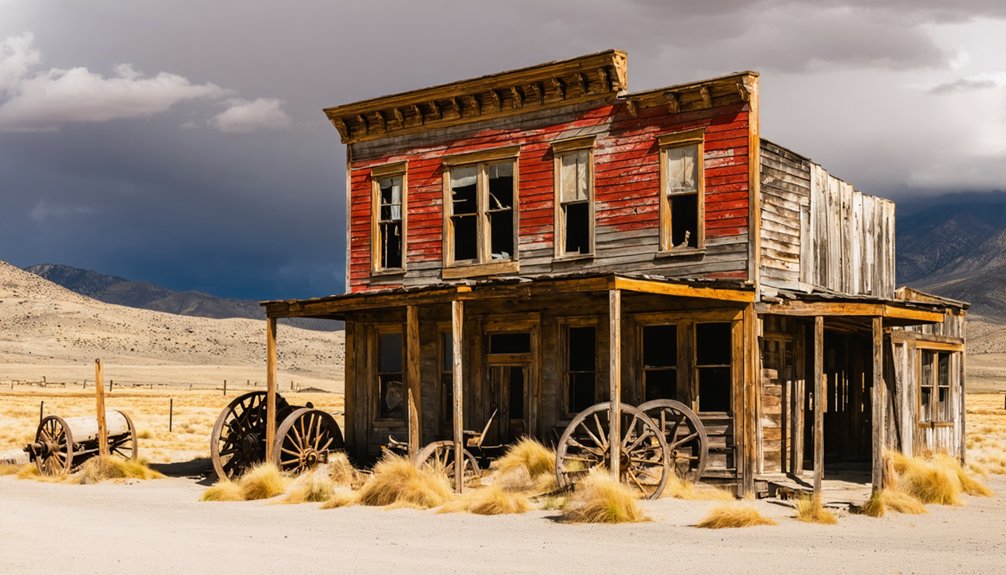America’s ghost towns offer hauntingly beautiful glimpses into our past. You’ll discover weathered saloons from gold rush boomtowns, abandoned factories of the Rust Belt, and communities evacuated after environmental disasters. These forgotten places tell stories of ambition, struggle, and resilience through their crumbling architecture and scattered artifacts. Walking these empty streets, you’ll connect with diverse cultural histories and economic cycles that shaped our nation. Each deserted doorway beckons with untold secrets waiting to be explored.
Key Takeaways
- Bodie, California presents a perfectly preserved gold rush town maintained in “arrested decay” with authentic period artifacts.
- Centralia, Pennsylvania became uninhabitable due to an underground coal fire that has been burning since 1962.
- Cahawba, Alabama offers archaeological insights as Alabama’s first state capital before abandonment due to flooding.
- St. Elmo, Colorado features well-preserved mining structures and attracts tourists interested in the American West’s boom-bust cycle.
- Virginia City stands as a testament to mining prosperity with Victorian architecture and historical significance from the Comstock Lode silver discovery.
Gold Rush Ghosts: Mining Towns Frozen in Time
As you wind along forgotten mountain roads, America’s gold rush ghost towns emerge like time capsules from another era, their weathered facades and empty streets whispering tales of fortune and failure.
From Bodie, California to Goldfield, Nevada, these once-bustling boomtowns swelled rapidly as prospectors perfected their mining techniques, only to collapse when the precious veins ran dry.
You’ll find Victorian architecture standing defiantly against time, alongside rusted headframes and abandoned mine shafts.
Many towns experienced multiple revivals before surrendering to the inevitable. Mining began with Spanish miners in the late 1600s, long before the famous California gold rush sparked widespread mineral pursuits.
These boom-and-bust cycles repeated like stubborn echoes before silence finally claimed the once-vibrant mining communities.
Today, their saloons, general stores, and schoolhouses preserve the diverse community life that thrived during their heyday.
The town of Bannack, Montana stands out with over 50 structures still preserved, allowing visitors to walk through Montana’s first territorial capital.
Local museums safeguard artifacts while ghostly legends swirl through these skeletal communities.
Each abandoned town tells a unique story of America’s resource-driven past—monuments to ambition, greed, and the freedom sought by those who dared to chase golden dreams.
Unnatural Disasters: Towns Evacuated by Environmental Crisis
While many American towns faded slowly through economic decline, others met more dramatic and abrupt ends when environmental disasters forced rapid evacuations and permanent abandonment.
You’ll find the remains of flooded towns like Kennet, California, now sleeping beneath Lake Berryessa’s waters, and Vanport, Oregon, which vanished in a catastrophic 1948 flood.
Even more unsettling are America’s toxic wastelands – Love Canal, where chemical leaks sparked a health crisis, and Times Beach, Missouri, condemned by dioxin contamination.
In Centralia, Pennsylvania, an underground coal fire still burns, forcing residents to flee toxic gases. The government issued a formal evacuation in 1984 when the situation became untenable, though a handful of determined residents refused to leave.
Valmeyer, Illinois experienced catastrophic flooding along the Mississippi River in 1993, forcing nearly all of its 900 residents to relocate to higher ground.
Climate change claims its own ghost towns too. Holland Island surrendered to rising seas, while Dust Bowl communities across the Great Plains withered when the soil itself betrayed them.
Walking Through History: America’s Best-Preserved Ghost Towns
Unlike the abandoned towns left desolate by environmental tragedies, America’s best-preserved ghost towns stand as living museums where you can walk the same streets that miners, merchants, and madams once tread.
Bodie’s “arrested decay” captures California’s gold fever with original artifacts still sitting on dusty shelves.
Step into Bodie and witness frozen moments of the gold rush, where history waits patiently in the dust.
St. Elmo invites you into Colorado’s mining heyday, while Virginia City’s wooden sidewalks echo with silver rush fortunes.
In Terlingua, Texas, mercury mining ruins bask under desert sunsets near Big Bend’s majestic vistas.
Ghost town preservation efforts have transformed these forgotten outposts into time capsules of historical significance.
At high-altitude Animas Forks, you’ll discover what drove people to build lives in seemingly impossible places—the same pioneering spirit that defines America’s quest for freedom and opportunity.
Kennecott offers stunning views of copper mining infrastructure nestled within the breathtaking landscape of Wrangell-St. Elias National Park.
These historic sites benefit from the work of WikiProject Ghost towns, an open collaboration of editors dedicated to improving Wikipedia’s coverage of abandoned settlements worldwide.
Lost Economies: When Industry Abandoned Small-Town America
The smokestacks that once billowed with promise now stand silent against small-town skylines, marking the graveyards of America’s industrial heartland.
You’ll find these stories etched into the abandoned factories of Danville, where 6,500 textile jobs vanished, and Youngstown, where 40,000 steel workers lost their livelihoods.
Walk through Flint or Baltimore and you’ll encounter block after block of vacant homes—physical reminders of community decline following massive job loss.
As NAFTA and globalization accelerated, entire economic ecosystems collapsed. Muncie lost 10,000 factory positions, leaving thousands of empty houses and broken families in its wake.
What you’re witnessing isn’t just economic transformation but the unraveling of America’s working-class fabric—where factories once fostered pride, now abandoned buildings stand as monuments to forgotten promises. Former manufacturing workers transitioning to service sector jobs experienced a devastating 19.2% decline in their standard of living. The China trade shock alone resulted in 3.4 million American manufacturing jobs disappearing since 2001, devastating communities that once thrived on industrial labor.
Hidden Stories: The Cultural Legacy of America’s Forgotten Places
Beyond crumbling walls and overgrown streets, America’s abandoned towns harbor rich cultural legacies that whisper tales of bygone eras.
When you walk among these silent structures, you’re not just witnessing decay—you’re experiencing living archives of community values and resilience.
Each weathered church steeple and collapsed schoolhouse tells stories of ambition, celebration, and struggle.
These architectural remnants serve as emotional connections to our collective past, preserving identities that might otherwise vanish with economic decline.
You’ll find places like Cahawba, Alabama, where archaeological remains offer insights into complex social histories. Matthew Christopher’s extensive documentation captures how these sites reflect urban disinvestment and economic cycles that transformed once-thriving communities.
Bodie, California stands frozen in time, with artifacts and buildings preserved exactly as they were left, offering visitors a genuine Gold Rush experience unlike any modern recreation could provide.
Other towns have found new purpose through cultural preservation efforts, transforming from forgotten ruins into heritage tourism destinations.
In their silent narratives, these ghost towns remind us that even abandoned places remain powerful vessels of memory.
Frequently Asked Questions
Are Ghost Towns Legally Open for Overnight Camping or Exploration?
Most ghost towns require permissions—they’re usually on private property or regulated public lands. You’ll need to check ghost town regulations and guarantee camping safety before venturing into these crumbling portals to America’s past.
What Ghost Towns Have Paranormal Activity or Documented Hauntings?
Over 100 documented hauntings exist across America’s ghost towns. You’ll encounter chilling ghost stories in Bodie, California, while Silver City’s haunted history features flying objects and spectral miners seeking their eternal rest.
Can I Take Artifacts or Souvenirs From Abandoned Towns?
No, you shouldn’t take artifacts. You’re breaking souvenir regulations and artifact ethics, disturbing history’s whispers. Penalties await on public lands, while private property requires owner permission for these dusty treasures.
Which Ghost Towns Are Accessible Without Four-Wheel Drive Vehicles?
You’ll discover numerous accessible ghost towns without needing 4WD: Rhyolite, Goldfield, Calico, Bodie, Amboy, and several Route 66 relics all welcome your standard vehicle on their history-steeped, paved pathways.
Are There Abandoned Towns Where People Still Legally Live?
Like flickering embers in a dying fire, you’ll find people maintaining legal residency in several abandoned communities. Centralia and Thurmond exemplify where freedom-seekers stubbornly hold onto their historical homes despite mass exodus.
References
- https://www.mentalfloss.com/geography/wanderlust/creepiest-ghost-towns-united-states
- https://en.wikipedia.org/wiki/Wikipedia:WikiProject_Ghost_towns
- https://www.thetravel.com/us-ghost-towns-that-are-still-abandoned/
- https://handbill.hk/editor_upload/file/1f47de58-e829-419c-ab5d-deae4a07d2ca.pdf
- https://www.geotab.com/ghost-towns/
- https://www.youtube.com/watch?v=9sqf1Ayk3N0
- https://whakestudios.com/us-ghost-towns/
- https://en.wikipedia.org/wiki/Ghost_town
- https://en.wikipedia.org/wiki/Lists_of_ghost_towns_in_the_United_States
- https://travelpander.com/abandoned-towns-in-the-u-s/



